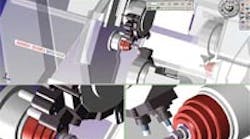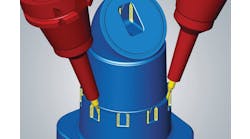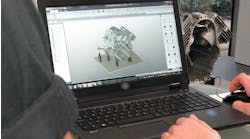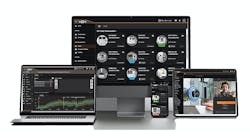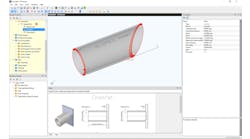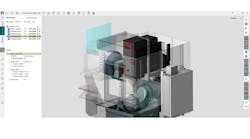Introducing sophistiated or complex machine tools starts with thoughtful planning. Builders usually ensure availability of software for their machines by developing or adapting their own, or by consulting CAM suppliers in advance of a machine’s introduction, to ensure immediate productivity.
Mori Seiki USA, Inc. is one such machine builder. The company frequently works with external sources to maximize customer benefit.
Nitin Chaphalkar, Mori Seiki team leader for the company’s NZ machine series development, explained: “When we develop a product plan we include all the components that we cannot develop, but which are necessary to provide a good solution. We need to provide these external components, so the customer can use our technology efficiently.”
Mori Seiki’s Chicago Machine Technology Laboratory (MTL) provides continuing support to customers, while its Digital Technology Laboratory (DTL), in Sacramento, Calif., provides guidance to CAD/CAM companies working with Mori Seiki machines.
In collaboration with software developer Gibbs and Associates, the Mori Seiki laboratories ensured that the popular GibbsCAM software could go beyond programming the Mori Seiki NT and NZ multi-tasking machines upon their introductions.
Chaphalkar elaborated, “If the customer is using a weak or incapable CAM system, he will not get the desired benefits from the machine, and ultimately will blame the machine, at least in part. All components must work together, and that is the purpose of working with Gibbs and other companies.”
Detlef Streichert, Mori Seiki NT specialist engineer, says the NT was developed with a goal of maintaining the same function, performance and axial stroke (travel) for milling as the company’s standard machining centers of equivalent size, and the same capabilities of equally sized lathes. “We achieved 95% of the milling without sacrificing any of the multi-axis turning, primarily because of a constant Y-axis stroke, without triangulation, and a B-axis tool on a direct drive motor.”
With up to nine axes, the NT is designed to reduce setups and remove material as efficiently and accurately as possible – making complex, multi-axis parts with tight tolerances, highquality finishes and in minimal operations.
“The machine is extremely capable, but very difficult to program,” said Streichert. “Also, it is very difficult to find a CAM system that does milling and turning equally well and one that takes advantage of the machine’s features.”
Chaphalkar contrasts the NZ as “a highly rigid, three-turret machine, with up to 12 axes, designed for mass production, where you load the machine and let it run. The NZ is for high output and fast throughput. Cycle time and machine speed are critical.”
Andy Heffner, Gibbs application engineer and multi-task machining specialist, said that Gibbs developed the NT postprocessor early in the machine’s introduction, then enhanced GibbsCAM to fully program the NT’s B-axis, swiveling-tool spindle.
GibbsCAM MTM has always been strong in programming the NT with full five-axis simultaneous movement on the B axis, including the lower turret with its second tool group. Heffner explained that the challenge for other CAM systems is to provide an integrated milling-turning interface. Other software providers will use a milling and a turning package, he said, then “cut and paste operations, and hope and pray for no mistakes.”
The NZ presents a greater challenge, with multiple turrets making small parts, usually with two turrets working simultaneously, or all three engaged.
“With so much simultaneous motion, the CAM system must check for interference, enable different approaches, easily shift operations among the turrets, and realize an overall shorter cycle time,” added Chaphalkar. “All this, and calculating accurate cycle times, are CAM system requirements.”
Heffner added that, combined, Mori Seiki’s requirements are: 1) full 5-axis simultaneous programming; 2) synchronizing up to three turrets and balancing the program; 3) providing full utility (noncutting) operations; 4) machine simulation; 5) predictive, minimal cycle times for the NZ; and 6) all done with integrated software.
Heffner said GibbsCAM MTM is very powerful, with integrated turning and milling, along with the ability to do full simultaneous machining with the upper turret’s X, Y, Z, B and C axes. “More so,” he added, “we have the advantage of Sync Manager within MTM to control synchronization of tool groups, maximize simultaneous use of turrets, and minimize cycle time.”
Sync (or wait) codes are used in multi-task machining programs to force a turret to stop and wait for another to finish an operation when running them simultaneously would cause collisions. Seemingly at odds with collision avoidance, efficient machining requires maximizing simultaneous operations.
Heffner, an experienced manual programmer himself, said that manually inserting sync codes is very difficult. “Multiple operations are typical, and it is too easy to confuse operations or locations, and to get out of sequence. If you make a mistake, you can almost guarantee a crash,” he explained. “Now, add a third turret for the NZ and see what happens.”
GibbsCAM MTM Sync Manager shows the operations for each turret side by side. When the programmer sees potential conflicts opposing each other, he inserts a wait code in one operation with a mouse click, linking it with the same code to the opposing operation on the second or third turret, simultaneously linking them, visually, with a blue line.
Streichert said synchronization and timing to maximize overlapping operations is the greatest benefit.
“Having as many tools as possible working simultaneously requires a very clever CAM system,” he said, “especially for the NZ, which could have three turrets working on two spindles. Gibbs- CAM is a very good tool for synchronizing and maximizing overlap.”
Some Mori Seiki machines have a collision- avoidance system, first implemented within the NT, then the NZ and the 5-axis NMV machining center. From the NC code, it determines potential tool positions within a millisecond. If it calculates a potential collision, it stops the machine.
“This is a great feature,” said Streichert, “It gives customers the best first level of support, but does not guarantee prevention. Collision prevention is a critical safety requirement for CAM systems, and as we add more advanced features, it will be even more important.”
For collision detection and avoidance, GibbsCAM uses Cut Part Rendering, which displays dynamic material removal, and machine simulation, which displays moving machine components while the program runs.
When Gibbs needed to add the NT and NZ to its simulation library, Mori Seiki DTL provided solid models of machine components, saving time and ensuring accuracy, since the models were those used for building the machines. Gibbs assembled the models into a complete articulated machine, enabling GibbsCAM Machine Simulation to display the machines and moving components as they run NC programs.
The collaborative projects are a continuation of other efforts. Two years ago, Gibbs worked closely with Mori Seiki and Renishaw to implement a probing plug-in within GibbsCAM for the 5-axis NMV. In 2008, in preparation for the NZ’s introduction, Gibbs programmed three parts for Mori Seiki’s IMTS exhibit.
Nitin Chaphalkar cited a more recent project. “The result of a collaborative effort with Kennametal, our spinning tool, which uses an inserted tool on a direct-drive motor on the NL, NT and NZ machines, is a continuing project with Gibbs and other CAM companies. The concept is so new that changes are required to the CAM software and postprocessors. This, and optimizing cycle time are critical, continuing projects.”
Information for this report supplied by Gibbs and Associates.
